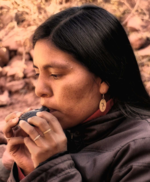Black hair
This article appears to contradict the article Human hair color. |
Black hair is the darkest and most common of all human hair colors globally, due to larger populations with this dominant trait. It is a dominant genetic trait, and it is found in people of all backgrounds and ethnicities. It has large amounts of eumelanin and is more dense than other hair colors. In English, various types of black hair are sometimes described as soft-black, raven black, or jet-black. The range of skin colors associated with black hair is vast, ranging from the palest of light skin tones to dark skin. Black-haired humans can have dark or light eyes.
Distribution[]
This article possibly contains original research. (October 2019) |
Black hair is most common in Asia and Africa.[1]Though this characteristic can also be seen in people of Southern Europe it is less common.[2] People of Celtic heritage in Ireland with such traits are sometimes known as the "Black Irish".[3]
Hair is naturally reflective, so black hair is not completely dark in bright light. However, the darkest shade will not have a warm, neutral tone but a sheen which can seem almost blue, like the iridescence of a raven's wing; hence, sometimes referred to as raven-black.[citation needed]
Genetics[]
Black-haired people of Amerindian, East Asian, Southeast Asian, Southwest Asia, The Middle East, Far East Russia, South Asian and the Himalaya have thicker and straighter hair due to the Derived EDAR gene allele that is linked to thicker and straighter hair and shovel-shaped incisors. The derived EDAR gene arose approximately 30,000 years ago in China.[4][5][6] One study[which?] shows that Paleo-Indians had both variants of the EDAR gene, the derived G-allele and the ancestral A-allele. When they[who?] tested ancient DNA remains found in the Americas of the individuals named USR1, Anzick-1 and Laranjal-6700 the results showed that they carried the ancestral A-allele.[citation needed]
11,000-year-old remains of Cuncaicha and Lauricocha individuals from South America share alleles at the highest rate with present-day Amerindians, indicating that the derived G-allele increased in frequency in parallel with the ancestral A-allele.[7]
Gallery[]

Indonesian senior woman with black hair from behind.

Chinese girl with black hair.

A Circassian woman with black hair.

Amerindian with black hair with the derived G-allele

Amerindian with black hair from North America with the ancestral A-allele

Amerindian with black hair from South America with the derived G-allele
See also[]
- Brown hair
- Hair dye
- Human hair color
- Human skin color
- Melanin
- Moreno
- Mustache
- Pigment
- Skin
References[]
- ^ Goodley, Alvin (2019-10-18). "4 Rarest Hair Colors in the World".
- ^ The Distribution of Anthropological Traits in Europe, Bertil Lundman: The Races and Peoples of Europe (New York 1977)
- ^ Hornbeck, Shirley Elro (2000-01-01). This and that Genealogy Tips. Genealogical Publishing Com. ISBN 9780806350271.
- ^ "Amerindians and Asians carry a version of the EDAR gene that is linked to thicker hair shafts". 23 April 2018.
- ^ Kamberov, Yana G.; Wang, Sijia; Tan, Jingze; Gerbault, Pascale; Wark, Abigail; Tan, Longzhi; Yang, Yajun; Li, Shilin; Tang, Kun; Chen, Hua; Powell, Adam (2013-02-14). "Modeling recent human evolution in mice by expression of a selected EDAR variant". Cell. 152 (4): 691–702. doi:10.1016/j.cell.2013.01.016. ISSN 0092-8674. PMC 3575602. PMID 23415220.
- ^ Hlusko, Leslea J.; Carlson, Joshua P.; Chaplin, George; Elias, Scott A.; Hoffecker, John F.; Huffman, Michaela; Jablonski, Nina G.; Monson, Tesla A.; O’Rourke, Dennis H.; Pilloud, Marin A.; Scott, G. Richard (2018-05-08). "Environmental selection during the last ice age on the mother-to-infant transmission of vitamin D and fatty acids through breast milk". Proceedings of the National Academy of Sciences of the United States of America. 115 (19): E4426–E4432. doi:10.1073/pnas.1711788115. ISSN 0027-8424. PMC 5948952. PMID 29686092.
- ^ "Reconstructing the Deep Population History of Central and South America".
External links[]
![]() Media related to Black hair at Wikimedia Commons
Media related to Black hair at Wikimedia Commons
- Hair color







